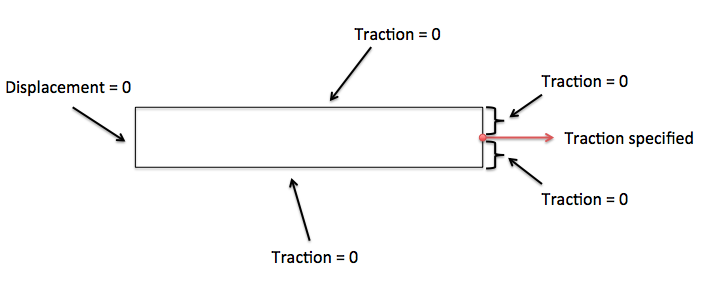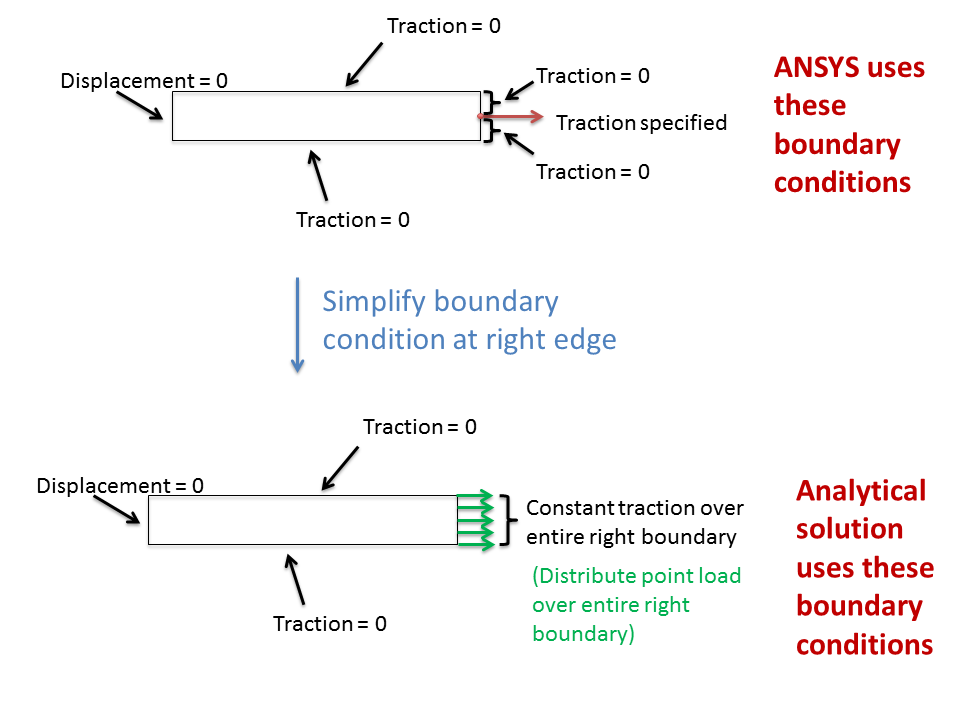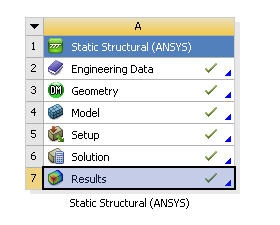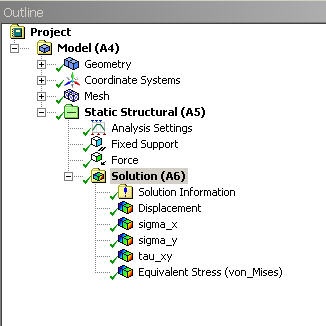| Include Page | ||||
|---|---|---|---|---|
|
| Include Page | ||||
|---|---|---|---|---|
|
| Note |
|---|
If equations below don't display properly and you get a "latex plugin" error, please refresh the page. |
Pre-Analysis and Start-Up
In the Pre-Analysis step, we'll review the following:
- Mathematical model: We'll look at the governing equations + boundary conditions and the assumptions contained within the mathematical model.
- Hand-calculations of expected results: We'll use an analytical solution of the mathematical model to predict the expected stress field from ANSYS. We'll pay close attention to additional assumptions that have to be made in order to obtain an analytical solution.
- Numerical solution procedure in ANSYS: We'll briefly overview the solution strategy used by ANSYS and contrast it to the hand calculation approach.
Mathematical Model
We'll first list the assumptions in the mathematical model. Then, we'll review the governing equations and boundary conditions that form the mathematical model. Note that this type of a mathematical model where you have a set of differential equations together with a set of additional restraints at the boundaries is called a Boundary Value Problem (BVP). A lot of practical problems that are solved using ANSYS and other FEA software are BVP's. You should have encountered simple BVP's in your math courses, problems of the kind that involve solving a differential equation with a set of boundary conditions (I was never good at these math problems and it showed in my math grades to the displeasure of my parents .... fortunately that is now a distant memory!). You can think of the BVP considered in this tutorial as a souped-up version of simpler BVP's you have encountered in math courses (and either liked or hated!).
Assumptions
We'll assume that:
Plane stress conditions apply since the bar is thin, thus we don't expect significant variation of stresses in the z direction:
Latex \begin{align*} \sigma_{z}
...
= \tau_{xz} = \tau_{yz} = 0
...
\end{align*}
Gravity effects can be neglected i.e. no body forces.
Latex \begin{align*} F_x = F_y =0 \end{align*}
Governing Equations
Since we are assuming plane stress conditions, we can use the 2D version of the equilibrium equations. When the deformed structure reaches equilibrium, the 2D stress components should satisfy the 2D equilibrium equations with zero body forces:
| Latex |
|---|
\begin{align*equation} {latex}\\ . The deformed structure will be in equilibrium. So the stress components should satisfy the three Below you will see that the analytical method makes assumptions that the ANSYS simulation does not. \\ !Different approaches.png! h6. Analytical Approach: h6. Assumptions made in this analysis * long bar (length is much greater than width) * no normal stresses in the y direction * plane stresses * no gravity effects * no end effects or point load effects (i.e. uniform stresses throughout the bar) h6. Analysis Assuming plane stresses: The two dimensional equilibrium equations are: \\ {latex} \begin{eqnarray} {\partial \sigma_x \over \partial x} + {\partial \tau_{yxxy} \over \partial y} + F_x = 0 \nonumber \\ {\partial \tau_{xy} \over \partial x} + {\partial \sigma_y \over \partial y} + F_y = 0 \nonumber \end{eqnarray} {latex} \\ Since we are ignoring the effects of gravity; there are no body forces per unit volume. {latex} \begin{eqnarray} F_x = F_y =0\nonumber \end{eqnarray} {latex} Assuming no normal stress in the y direction: {latex} \begin{eqnarray} \sigma_y = 0\nonumber \end{eqnarray} {latex} The equilibrium equation in the y direction becomes: {latex} \begin{eqnarray} {\partial \tau_{xy} \over \partial x} = 0\nonumber \end{eqnarray} {latex} τ_yx must also be a constant, therefore the equilibrium equation in the x-direction becomes: {latex} \begin{eqnarray} {\partial \sigma_x \over \partial x} = 0\nonumber \end{eqnarray} {latex} Therefore; \\ {latex} \begin{eqnarray} \sigma_x = constant\nonumber \end{eqnarray} {latex} \\ Apply Boundary Conditions: If we make a cut at "A", as indicated in the problem specification, then the stress in A must be P/A. Therefore, \\ {latex} \begin{eqnarray} \sigma_x = P/A \end{eqnarray} {latex}\\ \\ \\ \\ \\ \\ h6. ANSYS simulation: In this exercise, the geometry creation, mesh generation, boundary value setting and choosing the correct solver has been bypassed. You will be given the solution with the hope that you will explore it thoroughly to understand the numerical solution. Please note: The ANSYS simulation solves for a 2 dimensional (x and y) boundary value problem. Compare this to what was done in the analytical section. 1. Download "Class demo1.rar" by [clicking here|^Class demo1.rar] The zip should contain: + class demo1 folder \- class demo 1_files folder \- class demo 1.wbpj Please make sure both the files and wbpj are in the folder, the program would not work otherwise. (Note: The solution was created using ANSYS workbench 12.0 release, there may be compatibility issues when opened with other versions). Be sure to extract before use. 2. Double click "Class Demo1.wbpj" - This should automatically open ANSYS workbench. 3. Double click on "Results" - This should bring up a new window. 4. On the left-hand side there should be an "Outline" toolbar 5. Look for "Solution (A6)" - Inside the tree structure should be - Solution information - Displacement - sigma_x - sigma_y - tau_xy The last four are where you can find the results you need to investigate for the next step in this tutorial. \\ [*Go to Results*|ANSYS 12 - Tensile Bar - Results] [See and rate the complete Learning Module|ANSYS 12 - Tensile Bar - Problem Specification] [Go to all ANSYS Learning Modules|ANSYS Learning Modules]align*} |
Boundary Conditions
We solve these equations in a rectangular domain and impose the appropriate boundary conditions. At every point on the boundary, either the displacement or the traction must be prescribed.
The bottom and top edges are free. If a boundary location is not constrained and can move freely, it can expand and contract without incurring stress. Thus, traction on the free edges is zero and we get
| Latex |
|---|
\begin{align*}
\sigma_y = \tau_{xy} = 0 \:\: at \: y = 0 \: and \: y = H
\end{align*} |
The left end is fixed. So both components of displacement are zero at this end:
| Latex |
|---|
\begin{align*}
u = v = 0 \:\: at \: x = 0
\end{align*} |
The boundary condition is a little bit more complicated at the right end. Here, the traction is specified at the mid-point where the point load is applied. The applied traction at all other points on the right boundary is zero. For brevity, we won't write out the corresponding equations at the right boundary. We'll simplify this boundary condition in our hand calculations below (to make the problem tractable) but the ANSYS solution provided uses the full set of boundary conditions. Another complication is that since we have a point load, the specified traction at the mid-point of the right end is infinite. We'll later discuss the effect of this in the ANSYS solution. Do keep in mind that there are no point loads in practice, it's just an idealization that can lead to weird behavior that we need to be aware of.
Hand Calculations
Now that we have reviewed the mathematical model for our problem, let's hold off diving into ANSYS just yet and first make some hand calculations of expected results. We'll use these hand calculations to check ANSYS results (like an expert engineer would!). In order to make the problem solvable by hand, we need to make additional assumptions. The ANSYS solution does not make these additional assumptions.
Additional Assumptions in Hand Calculations
We'll simplify the right boundary condition. Instead of a point load, we'll assume that the load is distributed over the entire right boundary. So the traction condition at the right boundary becomes
Latex \begin{align*} \sigma_x = P/(H \, t), \: \: \tau_{xy} = 0 \: \: \: at \: x = L \end{align*}Here, t is the thickness.
The following schematic shows the process of simplifying the right boundary condition in the hand calculation.
Away from the left and right ends, we expect a uni-axial state of stress with zero shear (OK, this is a bit of a leap of the imagination but it's plausible). So we'll assume that everywhere
Latex \begin{align*} \tau_{xy} = 0 \end{align*}We don't expect this to hold near the left boundary or in the vicinity of the point load, so our hand calculations won't be valid there.
Analytical Solution
With these additional assumptions in hand, we can easily solve the BVP and we get the following analytical solution:
| Latex |
|---|
\begin{align*}
\sigma_x = P/(H \, t), \: \: \: \sigma_y = 0
\end{align*} |
This is the well known (P/A) result but we have arrived at it somewhat carefully, accounting for the additional assumptions we made in the process. We'll need to keep these additional assumptions in mind when comparing the hand calculations with the ANSYS solution. For the values given in the problem statement, we have
| Latex |
|---|
\begin{align*}
\sigma_x = 2000/(10*1) = 200 \ N/mm^2 = 200 \ MPa
\end{align*} |
The corresponding strain in the x-direction can be calculated from Hooke' law:
| Latex |
|---|
\begin{align*}
\epsilon_x = \frac{\sigma_x}{E} - \nu \, \frac{\sigma_y}{E} = 1 \times 10^{-6}
\end{align*} |
The strain is tiny since the material is very stiff with an Young's modulus of 200 GPa. The displacement at the right end can be estimated by integrating the constant x-strain:
| Latex |
|---|
\begin{align*}
\epsilon_x = \frac{\partial u}{\partial x}
\end{align*} |
| Latex |
|---|
\begin{align*}
u(x=L) = \int_0^L{\epsilon_x} \, dx = 0.05 \, mm
\end{align*} |
The above hand calculations give us expected values of stress, strain and displacement which we'll compare with the ANSYS results.
Numerical Solution Procedure in ANSYS
The type of numerical solution procedure used by ANSYS is called finite-element analysis (FEA) or finite-element method (FEM). In FEA, we divide or "discretize" the domain into small rectangles or "elements" (hence the name finite element analysis). ANSYS obtains the numerical solution to the BVP in the discrete domain. ANSYS directly solves for the u and v displacements at selected points called "nodes". Everything else such as the stress variation is derived from these nodal displacements through interpolation. The nodes in our case are the corners of the elements as shown below. As you can imagine, the numerical solution should get better as you increase the number of elements.
The following figure summarizes the contrasts between the hand calculations and ANSYS's approach. One important point to keep in mind is that both start with the same mathematical model but use different assumptions and approximations to solve it. Also, in FEA, one always computes the displacement first and from that derives the stress. Contrast that to the hand calculations where we calculated the stress first and from that derived the displacement. The latter process works only for a few simple problems.
This brings us to the end of the Pre-Analysis section.
Start-Up: Load Solution into ANSYS
As mentioned before, we are providing the ANSYS solution so that you can focus on comparing the hand calculations with the ANSYS results (which is the goal of this exercise). Without further ado, let's download the ANSYS solution and load it into ANSYS.
1. Download "Tensile Bar Demo.zip" by clicking here
Unzip the file at a convenient location. You will see a folder called Tensile Bar Demo with the following contents:
- Tensile Bar Demo_files (this is a folder)
- Tensile Bar Demo.wbpj
Please make sure both these objects are in the unzipped folder, otherwise the solution will not load into ANSYS properly. (Note: The solution provided was created using ANSYS workbench 13.0 release, there may be compatibility issues when attempting to open with older versions).
2. Double click "Tensile Bar Demo.wbpj" - This should automatically open ANSYS Workbench (you have to twiddle your thumbs a bit before it opens up). You will then be presented with the ANSYS solution in the project page.
A tick mark against each step indicates that that step has been completed.
3. To look at the results, double click on Results - This should bring up a new window (again you have to twiddle your thumbs a bit before it opens up).
4. On the left-hand side there should be an Outline toolbar. Look for Solution (A6).
We'll investigate the items listed under Solution (A6) in the next step of this tutorial.
 Sign-up for free online course on ANSYS simulations!
Sign-up for free online course on ANSYS simulations!




